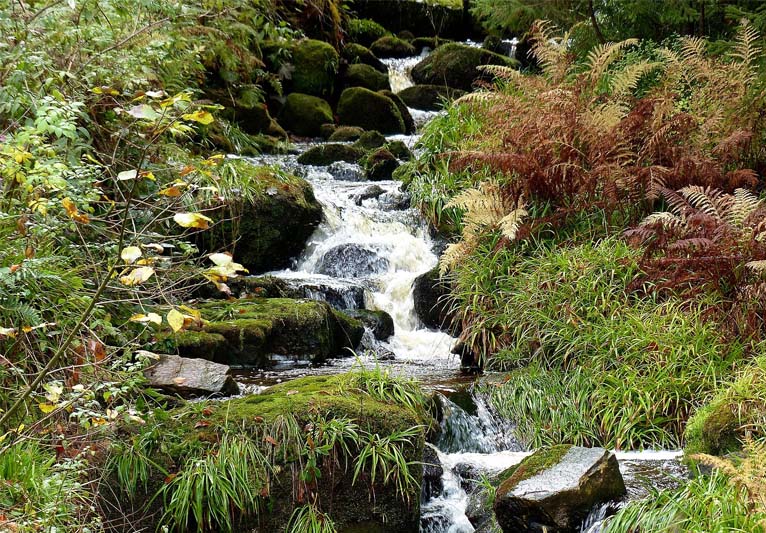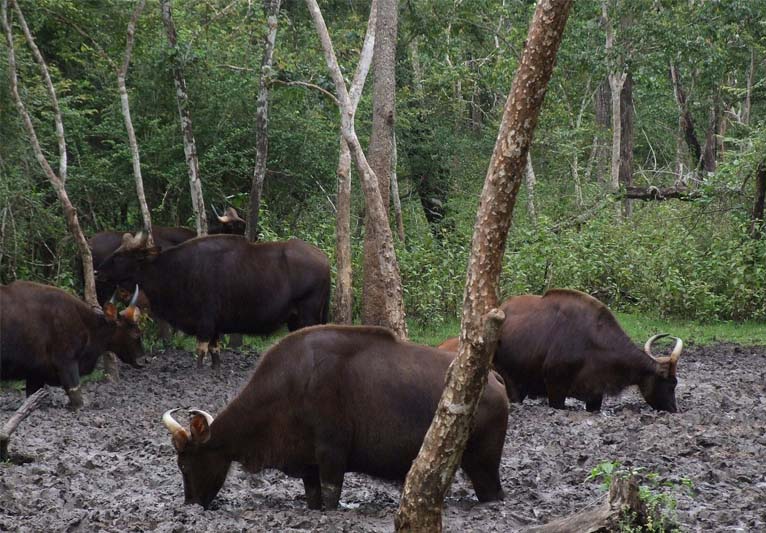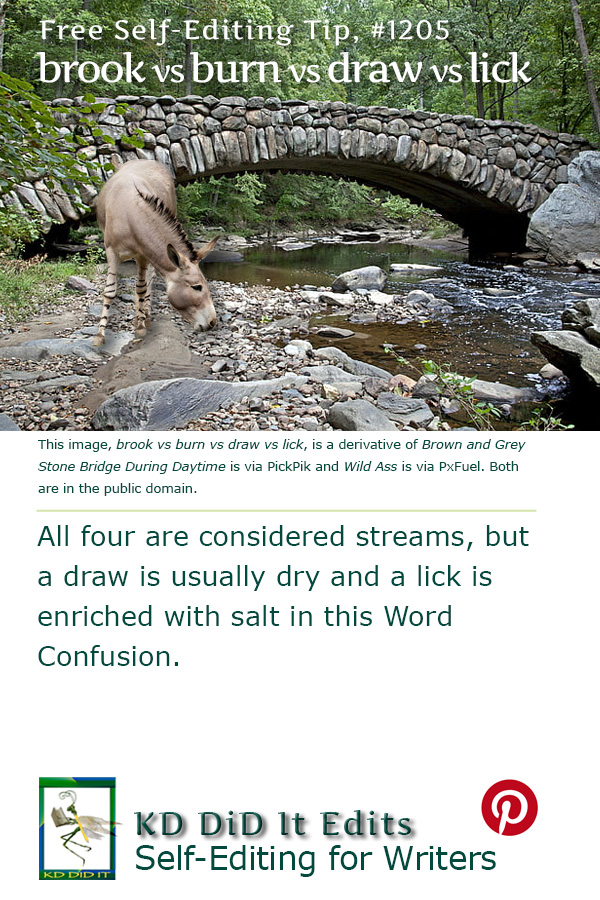I know . . . you’d think I’d be waterlogged by now. I’m’a gonna blame it on the weather. All this water is so cooling.
A brook is a small creek or stream.
A burn is also known as a bourn, a type of watercourse that can apply to a large stream or a small river. It’s a popular term in Scotland and England (especially North East England) and in parts of Ulster, Australia, and New Zealand.
A draw, a.k.a. a re-entrant, is most often dry with the ground sloping upward in three directions and downward in the other direction.
A lick is a small, temporarily flowing mineral-rich stream of salty water and salty mud. It attracts animals, making it a handy spot for hunters.
Exploring Later . . .
There’s also a bourn that is classified as a stream and its definition, etc., can be found in “Born vs Borne vs Bourn“. For more water posts, check out
You may want to explore “Anchorage, Haven, Moorage, and Roadstead“, “Arroyo vs Coulee vs Wadi vs Wash“, “Bay vs Bight vs Cove“, “Bayou vs Bog vs Marsh vs Swamp“, “Beach vs Coast vs Shore“, “Born vs Borne vs Bourn“, “Canal vs Impoundment vs Moat vs Reservoir“, “Cay vs Key vs Quay“, “Channel vs Dyke vs Rill“, “Creak versus Creek“, “Dam versus Damn“, “Delta vs Estuary vs Rapids vs Source“, “Dock vs Pier vs Wharf“, “Firth vs Fjord vs Gulf“, “Harbor vs Marina vs Port vs Quay“, “Lakes: Kettle, Loch, Mere, and Oxbow“, “Ocean versus Sea“, “Peer versus Pier“, “River vs Stream vs Tributary“, “Rivulet vs Runnel vs Sike“, “Sea versus See“, “Slew versus Slough“, and “Straight versus Strait“.
Word Confusions . . .
. . . started as my way of dealing with a professional frustration with properly spelled words that were out of context in manuscripts I was editing as well as books I was reviewing. It evolved into a sharing of information with y’all. I’m hoping you’ll share with us words that have been a bête noire for you from either end.
If you found this post on “Brook vs Burn vs Draw vs Lick” interesting, consider subscribing to KD Did It, if you’d like to track this post for future updates.
| Brook | Burn | Draw | Lick |
|---|---|---|---|
 |
 |
 |
 — |
| Part of Grammar: | |||
| Noun
Plural: brooks |
Noun
Plural: burns |
Noun
Plural: draws |
Noun
Plural: licks |
| A natural stream of water that’s not too deep and not too wide, usually shallow enough to walk through and sometimes you can even jump from one side to the other
A creek |
A small stream
A brook A bourn |
[US] A stream or creek that only fills after heavy rain but remains dry the rest of the time
[International] Re-entrant |
A small salt-rich watercourse or an ephemeral stream (it ranks hydrologically between a rill and a stream) |
| Examples: | |||
| The Lake District boasts lovely lakes and babbling brooks.
There are tiny fish and frogs in that brook. “The fly-and-worm is at its best in the quick-water pockets of late-spring brooks” (Ryan). There’s a brook that runs past the house. |
There is a burn running through the flower beds.
He climbed down into the burn. Many places took their names from the streams they grew up by, such as Fishburn, which was noted for its plentiful supply of fish, and Seaburn, which simply flowed into the sea (Simpson). |
“In a re-entrant or draw the ground always slopes downward in only one direction, and upward in the other three” (Re-entrant).
“A draw could be considered as the initial formation of a valley” (Map). “In a draw, there is essentially no level ground and little or no maneuver room within its confines (Map). “The garden, curiously enough, was a quarter of a mile from the house, and the way to it led up a shallow draw past the cattle corral” (Cather). |
“The lick’s proximity to the Ohio River, one of the main corridors for western exploration, made it an important stop for hunting and collecting salt to preserve meat” (Salt).
“The occurrence of big bones at the lick was noted on many subsequent European and Colonial maps of the western frontier of North America (anything west of the Appalachian Mountains)” (Salt). “Because wild game visited the spring at Big Bone Lick for its salt, Native Americans and then European and Colonial explorers visited the spring to hunt game” (Salt). |
| Derivatives: | |||
| Noun: brooklet | |||
| History of the Word: | |||
| Old English brōc is of unknown origin and related to the Dutch broek and the German Bruch meaning marsh. | Old English burna, burn(e) is of Germanic origin and related to the Dutch bron and the German Brunnen meaning well. | Dating only to 1882, this is an American term. | The sense of place where an animal goes to lick salt is from 1747. |
C’mon, get it out of your system, bitch, whine, moan . . . which words are your pet peeves? Also, please note that I try to be as accurate as I can, but mistakes happen or I miss something. Email me if you find errors, so I can fix them . . . and we’ll all benefit!
Satisfy your curiosity about other Word Confusions on its homepage or more generally explore the index of self-editing posts. You may also want to explore Book Layout & Formatting Ideas, Formatting Tips, Grammar Explanations, Linguistics, Publishing Tips, the Properly Punctuated, Writing Ideas and Resources, and Working Your Website.
Resources for Brook vs Burn vs Draw vs Lick
Some of these links may be affiliate links, and I will earn a small percentage, if you should buy it. It does not affect the price you pay.
Apple Dictionary.com
Cather, Willa. My Antonia. Originally published 1918. Union Square & Co., 2023. <https://amzn.to/3ONJxNN>. Ebook.
Cindy. “Life in a Brook Nature Study.” Our Journey Westward.com. 5 July 2022. Accessed 23 Aug 2023. <https://ourjourneywestward.com/life-in-a-brook-nature-study/>.
“Draw (Minor Terrain Feature).” Army Study Guide. n.d. Accessed 23 Aug 2023. <https://www.armystudyguide.com/content/Prep_For_Basic_Training/Prep_for_basic_land_navigation/draw-minor-terrain-featur.shtml>.
“Lick (stream).” Wikipedia. n.d. Accessed 23 Aug 2023. <https://en.wikipedia.org/wiki/Lick_(stream)>.
Map Basics and Identifying Terrain Features.” Train Like a Ranger.com. 30 Apr 2022. Accessed 23 Aug 2023. <https://www.trainlikearanger.com/post/navigating-the-course>.
Merriam-Webster: brook
Online Etymology Dictionary: lick
“Re-entrant (terrain).” Wikipedia. 14 Aug 2023. Accessed 23 Aug 2023. <https://en.wikipedia.org/wiki/Re-entrant_(terrain)>.
Ryan, Will. “Worm Fishing Tips: 12 Pro Secrets You Need to Know.” Field & Stream. 5 July 2023. Accessed 23 Aug 2023. <https://www.fieldandstream.com/fishing/how-to-fish-with-worms/>.
“A Salt Lick Puts Kentucky on the Map.” Kentucky Geological Survey, University of Kentucky. n.d. Accessed 23 Aug 2023. <https://www.uky.edu/KGS/education/did-big-bone-lick-map.php>.
WordSense: draw
Pinterest Photo Credits:
Brown and Grey Stone Bridge During Daytime is via PickPik and Wild Ass is via PxFuel. Both are in the public domain.
Revised as of 7 Apr 2024
By: Kathy Davie

